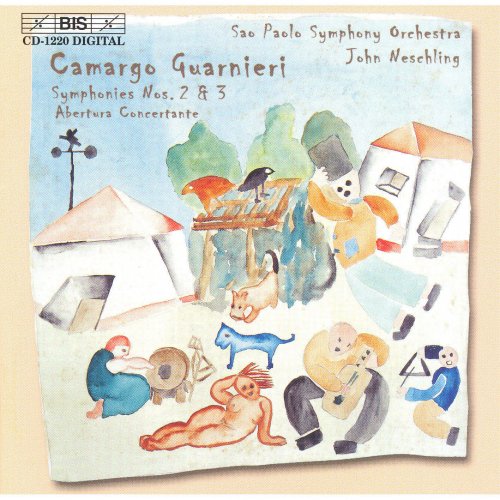
John Neschling, São Paulo Symphony Orchestra - Camargo Guarnieri: Symphonies Nos. 2 & 3, Abertura Concertante (2002) Hi-Res
BAND/ARTIST: John Neschling, São Paulo Symphony Orchestra
- Title: Camargo Guarnieri: Symphonies Nos. 2 & 3, Abertura Concertante
- Year Of Release: 2002
- Label: BIS
- Genre: Classical
- Quality: FLAC 24bit-44.1kHz / FLAC (tracks)
- Total Time: 01:15:09
- Total Size: 523 / 316 Mb
- WebSite: Album Preview
Tracklist:
Symphony No.2, ‘Uirapuru’ 29'16
01. I. Energico 8'06
02. II. Terno 11'35
03. III. Festivo 9'35
04. Abertura Concertante 11'45
Symphony No.3 32'43
05. I. Lento - Energico e violento 9'35
06. II. Serenamente - Vivo 14'32
07. III. Decidido 8'36
Performers:
São Paulo Symphony Orchestra
John Neschling, conductor
Symphony No.2, ‘Uirapuru’ 29'16
01. I. Energico 8'06
02. II. Terno 11'35
03. III. Festivo 9'35
04. Abertura Concertante 11'45
Symphony No.3 32'43
05. I. Lento - Energico e violento 9'35
06. II. Serenamente - Vivo 14'32
07. III. Decidido 8'36
Performers:
São Paulo Symphony Orchestra
John Neschling, conductor
This disc must be counted among the most interesting and important releases of the year. Brazilian composer Camargo Guarnieri (his real first name was Mozart, and he had three brothers: Bellini, Rossini, and Verdi) appears from time to time on pops programs, represented by some cute little Brazilian dance miniature, but he was in truth a major composer, and a symphonist of extraordinary mastery and confidence. While remaining true to his nationalist roots, his style owes nothing to that of Villa-Lobos, being far more disciplined and neo-classical in outlook. He shares something of the motoric drive and enthusiasm for counterpoint of Honegger, the folk-inspired melodic character of Bartók, and the plain-spoken directness of Copland. The result sounds like no one else and makes for some very satisfying listening.
All of the works here date from the period 1945-52 and show the composer working at a high level of inspiration. The Second Symphony shares its title, Uirapuru [a Brazilian bird] with the Villa-Lobos tone poem of the same name, and like the Third Symphony features rhythmically violent and virtuosic outer movements surrounding a longer central slow movement. In the Third Symphony the middle movement has a breezy scherzo at its center. These structural concerns greatly enhance the clarity of thought that characterizes all of this music. Listen, for instance, to how marvelously apt the first movement of the Third Symphony’s slow introduction sounds when it reappears as the same movement’s coda. Guarnieri clearly knows exactly where his music is going and delights in taking the listener along with him.
For all that, this isn’t “easy” music. There’s a nicely abrasive level of dissonance that when combined with highly contrasted melodic shapes and textures keeps each work’s thematic invention from sounding facile or cheap. The rhythmic intricacies of the symphonies’ outer movements make great demands on the orchestra, and in this respect the work of the São Paulo orchestra under conductor John Neschling is beyond praise. They attack these pieces with incredible energy and unbridled ferocity, to the extent that their playing in and of itself becomes a joy to hear. The orchestra also sports some excellent wind players, particularly flutes, oboes, and English horn, who distinguish themselves in the slow movements of both symphonies. BIS captures the whole affair in stunning recorded sound, completing a totally self-recommending package. If this disc isn’t the first in a complete Guarnieri orchestral music series, it will be a tragedy. What a brilliant, unexpected pleasure!
All of the works here date from the period 1945-52 and show the composer working at a high level of inspiration. The Second Symphony shares its title, Uirapuru [a Brazilian bird] with the Villa-Lobos tone poem of the same name, and like the Third Symphony features rhythmically violent and virtuosic outer movements surrounding a longer central slow movement. In the Third Symphony the middle movement has a breezy scherzo at its center. These structural concerns greatly enhance the clarity of thought that characterizes all of this music. Listen, for instance, to how marvelously apt the first movement of the Third Symphony’s slow introduction sounds when it reappears as the same movement’s coda. Guarnieri clearly knows exactly where his music is going and delights in taking the listener along with him.
For all that, this isn’t “easy” music. There’s a nicely abrasive level of dissonance that when combined with highly contrasted melodic shapes and textures keeps each work’s thematic invention from sounding facile or cheap. The rhythmic intricacies of the symphonies’ outer movements make great demands on the orchestra, and in this respect the work of the São Paulo orchestra under conductor John Neschling is beyond praise. They attack these pieces with incredible energy and unbridled ferocity, to the extent that their playing in and of itself becomes a joy to hear. The orchestra also sports some excellent wind players, particularly flutes, oboes, and English horn, who distinguish themselves in the slow movements of both symphonies. BIS captures the whole affair in stunning recorded sound, completing a totally self-recommending package. If this disc isn’t the first in a complete Guarnieri orchestral music series, it will be a tragedy. What a brilliant, unexpected pleasure!
Classical | FLAC / APE | HD & Vinyl
As a ISRA.CLOUD's PREMIUM member you will have the following benefits:
- Unlimited high speed downloads
- Download directly without waiting time
- Unlimited parallel downloads
- Support for download accelerators
- No advertising
- Resume broken downloads


